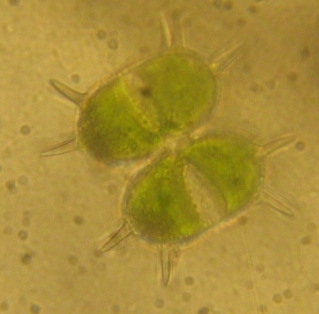
The Prorocentrales are a small order of dinoflagellates. They are distinguished by having their two flagella inserted apically, rather than ventrally as in other groups. One flagellum extends forward and the other circles its base, and there are no flagellar grooves. This arrangement is called desmokont, in contrast to the dinokont arrangement found in other groups. Accordingly, the Prorocentrales may be called desmoflagellates, and in some classifications were treated as a separate class Desmophyceae.

The glaucophytes, also known as glaucocystophytes or glaucocystids, are a small group of unicellular algae found in freshwater and moist terrestrial environments, less common today than they were during the Proterozoic. The stated number of species in the group varies from about 14 to 26. Together with the red algae (Rhodophyta) and the green algae plus land plants, they form the Archaeplastida.

Xanthidium is a genus of green algae, specifically of the Desmidiaceae.

Sykidion is a genus of green algae. Pseudoneochloris is a synonym of this genus. As of March 2022, Sykidion was the only genus in the family Sykidiacaeae, which was the only family in the order Sykidiales.

Chlorokybus is a multicellular (sarcinoid) genus of basal green algae or charophyte. It has been classified as the sole member of the family Chlorokybaceae, which is the sole member of the order Chlorokybales, in turn the sole member of the class Chlorokybophyceae. It grows on soil and rock surfaces, and is rare.
Mesostigma is a genus of unicellular biflagellate freshwater green algae, with a single species Mesostigma viride, covered by an outer layer of basket‐like scales instead of a cell wall. AlgaeBase classifies it as the only genus in the family Mesostigmataceae, the only family in the order Mesostigmatales, the only order in the class Mesostigmatophyceae. It is now considered to be one of the earliest diverging members of green plants/algae (Viridiplantae).
Pyrenomonas is a genus of cryptomonad.

Isochrysis is a genus of haptophytes. Until recently this genus was also thought to contain the 'T-iso' algae frequently used in aquaculture; that species has been reclassified as Tisochrysis lutea.

Plocamium is a genus of red algae in the family Plocamiaceae. It contains around 40 species and has a cosmopolitan distribution in temperate seas, although it is most diverse in the southern hemisphere. It is widely distributed in tropical and also warm-temperate and cold-temperate seas, such as northern Europe, the northern Arabian Sea and western Australia. They are also found in the Antarctic regions of Admiralty Bay and Terra Nova Bay.

Palmaria is a genus of algae. One of its most notable members is dulse, Palmaria palmata.

Rugulopteryx is a genus of brown algae in the family Dictyotaceae.

Rugulopteryx okamurae is a species of brown algae native to the temperate areas of the Northwest Pacific Ocean that has become invasive in the Mediterranean and Northeast Atlantic.
Rugulopteryx radicans is a species of brown algae in the family Dictyotaceae, and the type of the genus Rugulopteryx.
Rugulopteryx marginata is a species of brown algae in the family Dictyotaceae.







